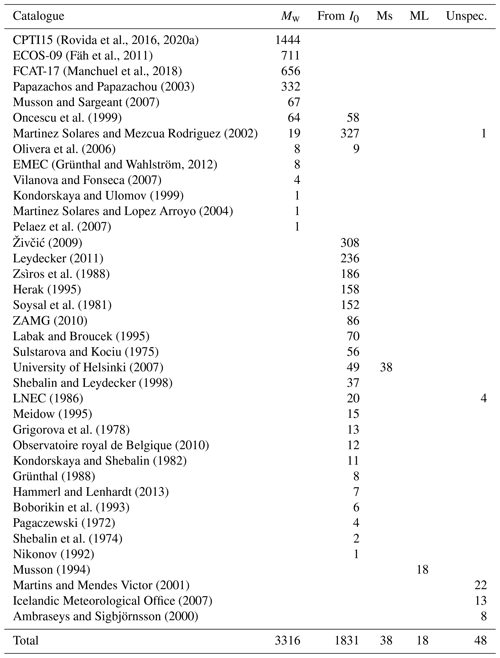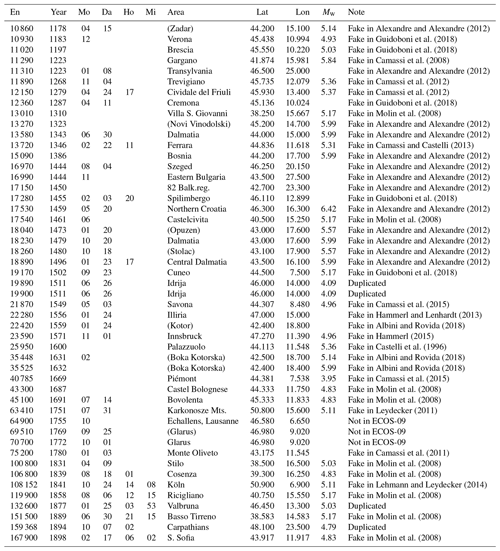the Creative Commons Attribution 4.0 License.
the Creative Commons Attribution 4.0 License.
The European Preinstrumental Earthquake Catalogue EPICA, the 1000–1899 catalogue for the European Seismic Hazard Model 2020
Andrea Antonucci
Mario Locati
The European PreInstrumental Earthquake CAtalogue (EPICA) (Rovida and Antonucci, 2021; https://doi.org/10.13127/epica.1.1) is the 1000–1899 seismic catalogue compiled for the European Seismic Hazard Model 2020 (ESHM20), an outcome of the project Seismology and Earthquake Engineering Research Infrastructure Alliance for Europe (SERA), in the framework of the European Union's Horizon 2020 research and innovation programme. EPICA is the update of the SHARE European Earthquake Catalogue (SHEEC) 1000–1899, with which it shares the main principles – mostly transparency, repeatability and continent-wide harmonisation of data – as well as the compilation strategies and methods.
Version 1.1 of EPICA contains 5703 earthquakes with either maximum intensity ≥5 or Mw≥4.0, with a spatial coverage from the Atlantic Ocean to the west to 32∘ E in longitude, and from the Mediterranean Sea to Northern Europe.
EPICA relies upon the updated knowledge of the European preinstrumental seismicity provided by the data gathered in the European Archive of Historical Earthquake Data (AHEAD). Such data are both macroseismic intensity data supplied by descriptive historical seismological studies and online macroseismic databases, and parameters contained in regional catalogues. As done for the compilation of SHEEC 1000–1899, these datasets were thoroughly analysed in order to select the most representative of the knowledge of each earthquake, independently from national constraints. Selected intensity distributions are processed with three methods to determine location and magnitude based on the attenuation of macroseismic intensity and are combined with parameters harmonised from modern regional catalogues.
This paper describes the compilation procedure of EPICA version 1.1, its input data, the assessment of the earthquake parameters and the resulting catalogue, which is finally compared with its previous version. Technical solutions for accessing the catalogue, both as downloadable files and through web services, are also illustrated.
- Article
(6824 KB) - Full-text XML
- BibTeX
- EndNote
Among their essential input datasets, seismic hazard evaluations require an accurate earthquake catalogue with a time coverage long enough to sample the temporal and spatial features of the seismicity of the study area. For this reason, in areas with moderate and low seismicity, such as most of Europe, earthquake parameters assessed with instruments in the last decades have to be integrated with those of preinstrumental earthquakes, usually derived from macroseismic observations. Parameters of macroseismic origin – magnitude in particular – have to be as consistent as possible both internally and with instrumental ones, and their reliability depends on the accuracy of the background historical research, and the approaches used for assessing them.
According to Rovida et al. (2020a), the availability and quality of preinstrumental earthquake data at the European scale are uneven because of the fragmentation of data repositories and their different features and levels of update. These authors also point out that only one-third of the European earthquakes of the period 1000–1899 CE are supported by descriptive studies supplying or not macroseismic intensity data, whereas another third is known only through parametric catalogues. For the latter earthquakes it is usually very difficult, and sometimes impossible, to trace back the historical information they rely upon. In addition, although the methodologies for assessing earthquake parameters from intensity data, each with its pros and cons, are nowadays robust, they rarely provide a unique solution from the same intensity dataset, and the selection of a single best method is not straightforward (Cecić et al., 1996; Bakun et al., 2011; Stucchi et al., 2013; Provost et al., 2022). This fragmentation and variety of both data and methods strongly affect the consistency of earthquake catalogues across country borders. For example, a very good representation of the long-term seismicity at the national scale is provided by the catalogues of Switzerland (ECOS-09; Fäh et al., 2011), France (F-CAT17; Manchuel et al., 2018) and Italy (CPTI15; Rovida et al., 2020b, 2022). These three catalogues provide robust parameters derived with advanced, well-calibrated and well-documented methodologies exploiting the richest historical macroseismic databases in the world. However, the common earthquakes in the three catalogues that occurred at the border of Switzerland, Italy and France in the Western Alps present diverse magnitude estimations due to the differences in both the input intensity distributions and the methods used for their processing. Such discrepancies of course have important consequences on the elaborations based on them such as, in the case of seismic hazard assessment, the computations of seismic activity rates, which may result in inconsistencies across country borders (e.g. Rong et al., 2011; Beauval et al., 2020; Provost et al., 2022).
In order to deal with this situation, the realisation of the European Seismic Hazard Model ESHM13 (Wössner et al., 2015) in the framework of the 2009–2013 project Seismic Hazard Harmonization in Europe (SHARE) included the compilation of an earthquake catalogue harmonised across national borders. In particular, the ESHM13 required a homogeneous catalogue compiled in terms of moment magnitude with transparent and repeatable procedures, based on the most updated knowledge provided by the results of previous European initiatives and by regional contributions. A specific task of the project aimed at the compilation of the 1000–1899 part of the earthquake catalogue from scratch, which resulted in the SHARE European Earthquake Catalogue (SHEEC) 1000–1899 (Stucchi et al., 2013; SHEEC 1000–1899 from now on). For earthquakes of the 20th century, a specific update (Grünthal et al., 2013) of the European-Mediterranean Earthquake Catalogue (EMEC) (Grünthal and Wahlström, 2012) was adopted.
In the framework of the Seismology and Earthquake Engineering Research Infrastructure Alliance for Europe (SERA) 2017–2020 project, the creation of the European Seismic Hazard Model 2020 (ESHM20; Danciu et al., 2021) and the new release of ESHM13 required an update of all the input datasets that were compiled almost 10 years before (Basili et al., 2018). Among these databases, the new version of SHEEC 1000–1899 was compiled and named European PreInstrumental Earthquake CAtalogue – EPICA version 1.1 (Rovida and Antonucci, 2021).
The present paper describes the new catalogue, which takes into account the available updates in the input data, summarising the procedures for their selection and parameterisation. After providing an overview of the catalogue content, with particular reference to the improvements with respect to its previous version, the availability and accessibility of the data are described.
The compilation of EPICA version 1.1 adopts the same procedures used for SHEEC 1000–1899, detailed in Stucchi et al. (2013) and summarised in Fig. 1. Previous efforts for the creation of a long-term continent-wide European earthquake catalogue, e.g. the pioneering works of Kárník (1969, 1971), Van Gils (1988), and Van Gils and Leydecker (1991), and the more recent EMEC catalogue (Grünthal and Wahlström, 2012), consisted of the recompilation of national earthquake catalogues and the conversion of their magnitudes to a common scale. To improve the cross-border homogeneity of the parameters, instead of collating national catalogues resulting from varied data and criteria, SHEEC 1000–1899 reassessed earthquake locations and magnitudes from raw macroseismic intensity data (macroseismic data points, hereafter MDPs), selected from a unified and homogeneous database, with the same procedures throughout Europe.
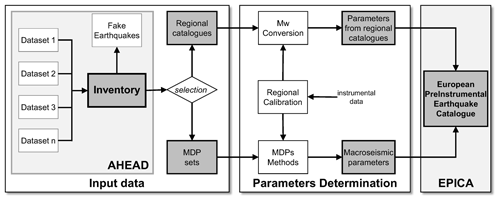
Figure 1Compilation procedure of EPICA version 1.1, adopted from SHEEC 1000–1899 (Stucchi et al., 2013). The input datasets are selected from the European Archive of Historical Earthquake Data (AHEAD), and the parameters are homogeneously reassessed from both macroseismic data (MDPs) and regional catalogues.
This approach followed for the first time the recommendations of Van Gils (1988) and Stucchi (1994), who recognised the limitations of merging national catalogues into a European one and suggested the creation of a unique database of primary data, both macroseismic intensity distributions and parametric catalogues, to serve as a base for the uniform assessment of earthquake parameters. Several European joint efforts of the last 20 years pursued the collection, integration and publication of historical earthquake data sparse in local and regional archives in varied formats, and the ultimate outcome is the European Archive of Historical Earthquake Data AHEAD (Albini et al., 2013; Locati et al., 2014; Rovida and Locati, 2015). AHEAD continuously collects, archives, organises and supplies data of different types and provenance on European earthquakes of the period 1000–1899 CE as derived from (i) regional and national macroseismic databases; (ii) seismological descriptive studies on specific earthquakes, periods or areas; and (iii) major modern parametric catalogues. In this way, AHEAD presents the multiplicity of studies and datasets that may refer to the same earthquake, providing diverse information. Datasets related to the same earthquake are thoroughly examined one by one, compared, and then associated.
SHEEC 1000–1899 exploited the wealth of data systematically inventoried in AHEAD analysing the datasets associated with each earthquake and selected among them the most representative of the knowledge of each earthquake, disregarding its national provenance. In the selection process, only published and/or publicly available datasets were considered, and those providing MDPs had the highest priority. In the presence of multiple sets of MDPs for the same earthquake, the selection considered the characteristics of the research that produced them, preferring datasets accompanied by thorough descriptions of the performed investigation, the consulted historical sources and their seismological interpretation. In general, the most recent datasets are selected, unless they provide the very same MDPs as older although more comprehensive studies. In the absence of any MDP sets for an earthquake, entries from parametric catalogues were chosen as the source of data for that earthquake. Also in these cases, preference was given to parametric catalogues accounting for their input information and the methods for assessing earthquake parameters. This procedure ensures the adoption of the most reliable and updated data, as well as the unequivocal identification of entries of different datasets related to the same earthquake, and earthquakes missing in one regional catalogue or another. In addition, catalogue entries related to fake events are easily recognised and sorted out.
Once a comprehensive and orderly list of earthquakes was made from AHEAD, the parameters of earthquakes with MDPs were assessed with three different methods: (i) Boxer 4.0 (Gasperini et al., 1999, 2010), (ii) MEEP (Musson and Jiménez, 2008) and (iii) BW (Bakun and Wentworth, 1997). These three methods rely on the attenuation of macroseismic intensity as a function of the earthquake magnitude and the distance of every MDP from the source, a feature that depends on regional attenuation characteristics and the peculiarities of intensity assessment. For each method, an attenuation model was calibrated for five European regions by means of the same set of calibrating events, i.e. earthquakes of known instrumental magnitude and with reliable MDP distributions (Gomez Capera et al., 2015). For earthquakes without MDPs, the most reliable location available from regional catalogues was adopted, and magnitude was reassessed from the conversion of epicentral intensity (I0) with five regional empirical relations specifically derived from the same dataset used for calibrating the methods for processing MDPs, for the sake of homogeneity.
Parameters from MDPs and regional catalogues were then used to assess a set of final parameters. The final location is the location determined from MDPs whenever it is available, or from regional catalogues otherwise. When Mw determinations from MDPs and from the regional catalogue are both available, the final Mw and related uncertainty is the weighted mean of them; otherwise, it is obtained either from MDPs or from regional catalogues.
Being the update of SHEEC 1000–1899 and adopting the same compilation procedures, EPICA version 1.1 had to take into account the new developments concerning both (i) input macroseismic datasets and catalogues and (ii) regional calibrations of the methods for parameterising MDPs or new methods. In the last years AHEAD has been updated with European macroseismic datasets and regional catalogues that have been subject to some updates and new publications, as detailed in the following. Conversely, since the publication of SHEEC 1000–1899 in 2013, new datasets on recent earthquakes that can significantly improve the used calibration datasets have not been published, and there were no major innovations to justify a revision of the regional calibrations. The only exception is the updated calibration of the Boxer method developed for the Italian catalogue CPTI15 (Rovida et al., 2020b). In addition, no robust new method for deriving location and magnitude from intensity data has been proposed in the literature.
In conclusion, the compilation of EPICA version 1.1 followed the same approach of SHEEC 1000–1899 described above (Fig. 1), incorporating new input datasets provided by the updated content of AHEAD and revising many choices, whereas the strategies for the definition of earthquake locations and magnitudes are unaltered. This approach also complied with the time and financial resources allocated by the SERA project for the ESHM20, which were considerably lower than those available in SHARE, entirely dedicated to ESHM13.
EPICA version 1.1 contains 5703 earthquakes with either maximum intensity ≥5 or Mw≥4.0, with a spatial coverage from the Atlantic Ocean to the west to 32∘ E in longitude and from the Mediterranean Sea to northernmost Europe. It relies upon 160 sources of MDPs and 39 parametric catalogues.
3.1 Input data
AHEAD, the European Archive of Historical Earthquake Data, is a dynamic repository, conceived to be continuously expanded and updated. In the period between the compilation of SHEEC 1000–1899 and EPICA, i.e. between 2012 and 2019, several new MDP sets and updated earthquake catalogues were published. Among the regional nodes contributing data to AHEAD, the Italian Archive of Historical Earthquake Data (Rovida et al., 2017; from now on ASMI: Archivio Storico Macrosismico Italiano) and the French macroseismic database SisFrance (BRGM-EDF-IRSN/SisFrance, 2016) underwent significant updates. At the same time, the results of several investigations on specific earthquakes, areas and/or periods have become available in the scientific literature. Consequently, the contents of AHEAD have been enriched with 81 sources of data not considered before, dealing with more than 6700 earthquakes, including 1488 new ones (Rovida et al., 2021). Out of the new data sources, 65 are macroseismic studies providing more than 90 000 MDPs, and five are updated regional earthquake catalogues. In addition, several records derived from sources already included were added, mostly because the minimum intensity considered in the archive was lowered. The current version of AHEAD, published online in May 2021, contains data on nearly 5800 earthquakes represented by more than 30 700 records derived from 360 sources, as well as 8180 intensity datasets with 145 500 MDPs in total. The number of AHEAD records related to a single earthquake ranges from 1 to 24, and about 74 % of the earthquakes are associated with more than two records, 8 % by 10 or more records. With respect to the version upon which SHEEC 1000–1899 was based, the number of earthquakes supported by MDPs increased from 57 % to 66 % of the total.
Following a thorough analysis of the content of AHEAD and the application of the criteria described above, with particular reference to new sources of data, a list of 5703 earthquakes supported by 160 sources of MDPs and 39 parametric catalogues (see https://www.emidius.eu/epica/data_sources.htm; last access: 22 March 2022) was selected for the compilation of EPICA version 1.1. MDP distributions are available for 3622 earthquakes, i.e. 64 % of those in the catalogue (Fig. 2). The selected sources of MDPs mainly consist of the regional nodes of AHEAD, namely the Italian Archive of Historical Earthquake Data ASMI, which in turn provides EPICA with 77 different sources of data, SisFrance, ECOS-09, the Greek Hellenic Macroseismic Database (HMDB.UoA; Kouskouna and Sakkas, 2013), the Macroseismic Database of the Southern Balkan area (University of Thessaloniki, 2003), and the Spanish macroseismic database (Instituto Geografíco Nacional, 2010). In all, these regional databases provide 78 % of the MDPs and 92 % of the earthquakes for which MDPs are available, i.e. 59 % of the earthquakes in EPICA. The remaining MDP sets derive from studies related to single earthquakes, small areas or specific periods. As a result, the geographical distribution of earthquakes with MDPs is rather unbalanced towards central (UK, France, Switzerland) and south-eastern (Italy, Greece) Europe (Fig. 2).
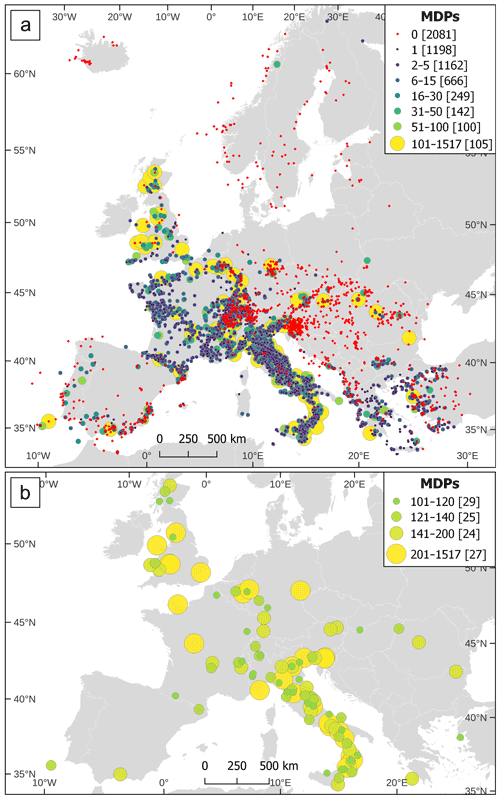
Figure 2(a) Number of MDPs for each earthquake in EPICA, according to the selected dataset. MDPs =0 means that MDPs are not available and a record from a parametric catalogue is selected. (b) Zoomed map of earthquakes with more than 100 MDPs. The number of earthquakes are indicated in brackets in the legends.
In addition to this geographical inhomogeneity, the input datasets, both catalogues and MDP sets, have different levels of updates throughout Europe. In all, sources of macroseismic data used in the compilation of EPICA derive from investigations published between 1975 and 2018, although most of them were published after the mid-1980s (Fig. 3a). In spite of the presence of many “old” datasets, Fig. 3b shows that the majority of the earthquakes with MDPs relies on datasets published after 2003. Indeed, in 2003 the Greek database of the University of Thessaloniki (2003) and a study contributing to most of the Hellenic Macroseismic Database (Taxeidis, 2003) were published, together with some studies on Italian and Swiss earthquakes. Afterwards, a large number of MDP sets related to many earthquakes were published starting from 2008, with several important contributions from Italy, Belgium and the UK. Most of the MDPs date between 2016 and 2018, thanks to the releases of the latest versions of SisFrance and of the Catalogue of Strong Italian Earthquakes (CFTI5med; Guidoboni et al., 2018), contributing 805 and 430 earthquakes respectively, although most of their content is the same as the previous versions. Out of the considered sources of MDPs, 36 studies providing MDPs to 2014 earthquakes are not among those used for SHEEC 1000–1899 mostly because they were not yet published or, in 10 cases, they were not considered although already available. These are mostly studies on Italian earthquakes, because ASMI did not yet exist at that time and the Italian portion of AHEAD was less updated than the rest of Europe. A similar temporal variance also affects the different 39 regional catalogues EPICA also relies upon (https://www.emidius.eu/epica/data_sources.htm; last access: 22 March 2022). These catalogues, related to 5511 earthquakes, are selected among those published taking into account both the transparency of their compilation procedures and their date of publication. Catalogues satisfying such criteria and covering all the study area date as far back as 1972, and nearly half of them are more than 20 years old (Fig. 3c), although these account for one-fifth of the earthquakes, only (Fig. 3d). With few exceptions, these catalogues are mostly related to low seismicity areas, such as Northern and Eastern Europe, and Portugal, and the majority of the earthquakes are reported in catalogues compiled in the last 10 years. However, as pointed out in Rovida et al. (2020a), the data that recent catalogues rely upon might be much older.
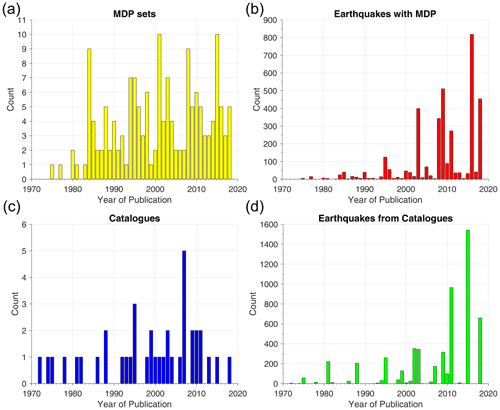
Figure 3Date of publication of the datasets used for the compilation of EPICA. Histograms to the top relate to sources providing MDP sets and show (a) the number of MDP sets according to the year of publication of their sources and (b) the number of earthquakes with MDPs according to the year of publication of their source. Histograms to the bottom show (c) the number of regional catalogues according to their year of publication and (d) the number of earthquakes from these catalogues according to the year of publication of the catalogue.
Following the selection principles of EPICA and in its period of interest (i.e. 1000–1899), only the four catalogues listed below have been published since 2012 and were considered in addition to or as a substitution of those contributing to SHEEC 1000–1899:
-
CPTI15 version 1.5 (Rovida et al., 2016, 2020b), contributing new parameters for 1541 Italian earthquakes;
-
FCAT-17 (Manchuel et al., 2018), contributing new parameters for 659 French earthquakes;
-
Hammerl and Lenhardt (2013), contributing new parameters for 8 earthquakes in Lower Austria;
-
Leydecker (2011), contributing the same data as the previous version for 236 German earthquakes.
In conclusion, for 3445 of the 5703 earthquakes in EPICA, both an MDP set and a parametric catalogue were selected, whereas for 2066 and 192 earthquakes respectively a record from a parametric catalogue or an MDP set were selected. It is worth noting that 145 earthquakes supported by MDPs and recent historical macroseismic investigations are not contained in any current or past earthquake catalogue. Conversely, AHEAD allowed EPICA to exclude about 180 earthquakes that, although present in the selected current earthquake catalogues, are assessed as fakes by published and consistent historical investigations.
3.2 Earthquake parameters
As mentioned in Sect. 2, parameters in EPICA were assessed following the same approach of SHEEC 1000–1899 (Stucchi et al., 2013; Gomez Capera et al., 2015), which foresaw the definition of two sets of parameters, each made of epicentre location with uncertainty, epicentral intensity, and magnitude and related uncertainty:
-
assessed from MDPs with homogeneous and repeatable procedures
-
derived from regional catalogues, coherently with those assessed from MDPs.
The combination of the two sets determines the final parameters, obtained from the selection of the location from either set (1) or (2) and assessing the magnitude as the weighted mean of those resulting from sets (1) and (2), depending on the availability.
The catalogue file displays the final parameters and those derived as both sets (1) and (2).
3.2.1 Parameters from MDPs
In EPICA, parameters from MDPs, referred to as set (1) above, are determined for 3297 earthquakes out of the 3622 for which MDPs are available, because the intensity distributions of the remaining 325 earthquakes are too meager to obtain robust parameters.
As in SHEEC 1000–1899, three methods for assessing macroseismic parameters were considered, i.e. Boxer (Gasperini et al., 1999, 2010), MEEP (Musson and Jiménez, 2008) and BW (Bakun and Wentworth, 1997).
Attenuation models specific for each method were defined by means of the same sets of recent calibrating events in five European regions (Fig. 4) defined for SHEEC 1000–1899 (see Stucchi et al., 2013; details and the relevant calibration parameters are in Gomez Capera et al., 2015):
-
stable continental region (SCR);
-
Western Alps and Pyrenees (WAP);
-
Betics (BET);
-
Apennines, north-eastern Alps and Dinarides (APD);
-
broad Aegean, shallow (BAS).
Four additional areas were defined in SHEEC 1000–1899 for earthquakes in Iceland (ICE), offshore Portugal (TSZ), in the Aegean with intermediate depth (BAI) and Vrancea (VRD), although no attenuation models were defined because of the lack of intensity data, and only catalogues were selected as input data in these areas (Fig. 4).
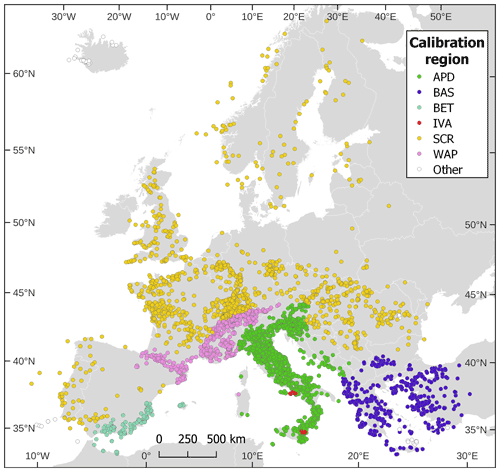
Figure 4Subdivision of earthquakes in EPICA represented according to the calibration regions defined for the assessment of the parameters. APD: Apennines, north-eastern Alps and Dinarides; BAS: broad Aegean, shallow; BET: Betics; IVA: Italian volcanic areas; SCR: stable continental region; WAP: Western Alps and Pyrenees.
Because of the lack of new or updated macroseismic data on recent earthquakes in most of Europe, the regional calibrations of SHEEC 1000–1899 have been applied unaltered in EPICA, apart from the APD region. In this area, the calibration of Boxer realised from an improved and robust set of MDPs and instrumental magnitudes for the Italian catalogue CPTI15 (Rovida et al., 2020b; this paper also shows the calibrated coefficients) superseded the outdated one from the CPTI04 catalogue (CPTI Working Group, 2004) that was considered in SHEEC 1000–1899. In addition, a new region was defined for the Italian volcanic areas (IVA) of Mt. Etna and Vesuvius–Phlegrean Fields, where a new I0 to Mw conversion strategy developed for the Italian catalogue CPTI15 (Rovida et al., 2020b) was adopted. This strategy copes with the peculiarity of ground motion attenuation and the low energy of the earthquakes in those volcanic areas. It consists of the determination of local magnitude from epicentral intensity with the relation for the Etna area by Azzaro et al. (2011), and then the conversion of local magnitude to Mw with two relations specific for Etna (Tuvè et al., 2015) and Vesuvius–Phlegrean Fields (Petrosino et al., 2008) in the respective areas.
Several trials of calibration and validation were performed all over Europe during the compilation of SHEEC 1000–1899. These extensive tests allowed for checking the stability of the methods and related regional coefficients and drove to the selection of Boxer for most events, with MEEP and BW used as exceptions respectively for earthquakes in the UK and for a few offshore events mostly in the Aegean Sea (BAS area). The summary of the parameters assessed with the three methods in the five regions is shown in Table 1.
Table 1Earthquakes with MDPs in each calibration region and method used for assessing parameters. APD: Apennines, north-eastern Alps and Dinarides; BAS: broad Aegean, shallow; BET: Betics; IVA: Italian volcanic areas; SCR: stable continental region; WAP: Western Alps and Pyrenees.

Empirical relations between epicentral intensity I0 and Mw (Table 2) are derived from the same datasets used for calibrating the three methods. Also in this case, the relations used in SHEEC 1000–1899 were applied in EPICA, except for the APD area.
3.2.2 Parameters from regional catalogues
The regional catalogues selected from AHEAD provide parameters (location and epicentral intensity or magnitude, or both) for 5251 earthquakes. In EPICA, locations are adopted from the catalogues without any modifications, whereas the magnitude is determined according to the same procedure adopted in SHEEC 1000–1899. In detail, as summarised in Table 3, Mw originally provided by catalogues is adopted without any modifications, otherwise it is reassessed from epicentral intensity according to the conversion relations in Table 2 and the region each earthquake belongs to (Table 4). In few remaining cases, only Ms or ML are supplied by the catalogue, and they are converted to Mw according to the relations of Bungum et al. (2003) and Grünthal et al. (2009), respectively. As an extreme case, four catalogues do not specify the adopted type of magnitude, and in the lack of any further information, it is assumed equivalent to Mw.
Table 2Empirical relations between epicentral intensity I0 and Mw defined in each calibration region from Stucchi et al. (2013) except that of APD, from Rovida et al. (2020b). APD: Apennines, north-eastern Alps and Dinarides; BAS: broad Aegean, shallow; BET: Betics; SCR: stable continental region; WAP: Western Alps and Pyrenees.

Table 4Number of earthquakes from regional catalogues considered in EPICA according to their calibration region and the origin of EPICA magnitude. APD: Apennines, north-eastern Alps and Dinarides; BAS: broad Aegean, shallow; BET: Betics; SCR: stable continental region; WAP: Western Alps and Pyrenees.
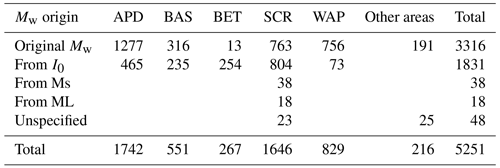
EPICA provides magnitude uncertainty for all the earthquakes. Among the considered regional catalogues, ECOS-09, F-CAT17, CPTI15, and Papazachos and Papazachou (2003) provide magnitude uncertainties, which are reported in EPICA, whereas for the other catalogues uncertainties are those associated with the conversion relation from I0, otherwise they are assumed as equal to 0.3 or 0.5.
3.2.3 Final parameters
Taking into account the selected datasets and the two sets of parameters assessed as described above, the final parameters in EPICA are determined as described in the following, where the names of the respective fields in the catalogue file are indicated in parentheses.
Origin time (Year, Mo, Da, Ho, Mi)
The time of occurrence of each earthquake is adopted from the study underlying the selected MDP set if present, otherwise it is adopted from the selected catalogue.
Location and uncertainty (Lat, Lon, TEpi, LatUnc, LonUnc, TEpiUnc)
The epicentral location determined from MDPs, i.e. Set (1) as described above, is always preferred to the location proposed by regional catalogues (Set 2), and the latter is adopted only for earthquakes without MDPs or when MDPs are not parameterised.
As a result, 3297 (57.8 %) epicentres in EPICA are from MDPs and 2257 (39.6 %) from the selected regional catalogues. In addition, 149 epicentres (2.6 %) relate to earthquakes for which the available data do not allow a robust determination of the location and are marked as “preliminary”. Among the locations from MDPs, 3187 are from Boxer, 82 from MEEP and 28 from BW (Fig. 5).
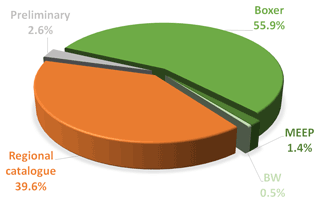
Figure 5Percentages of the different types of epicentre locations in EPICA. “Boxer”, “MEEP” and “BW” indicate the methods used for assessing epicentre from macroseismic data. Preliminary means that a robust determination of the location is not possible with the available data.
The uncertainty associated with epicentral locations from Set (1) are determined for 1944 earthquakes with the relevant method, namely 1869 with Boxer and 75 with MEEP. Both Boxer and MEEP calculate epicentral uncertainty only with enough data, while BW does not. When the uncertainties are not assessed, a default value of 30 km is assigned to epicentres of onshore earthquakes and of 50 km for offshore ones. For locations in Set (2), the uncertainty of epicentral location is taken from the selected catalogues (854 earthquakes) when provided and expressed in kilometres, otherwise it is converted into kilometres from degrees (116 earthquakes). Default values of 39.9 (for onshore earthquakes), 49.9 (for offshore earthquakes) or 99.9 km (when the catalogue proposes “undefined” uncertainty or values/classes >50 km) are adopted for 1158 earthquakes for which the selected catalogue does not provide epicentral uncertainty. Location uncertainty is not provided for 278 earthquakes.
Depth (H, Hunc, TH)
The assessment of the focal depth of historical earthquakes is controversial and affected by high uncertainties (e.g. Gasperini et al., 2010). For this reason, depth is provided for 738 earthquakes only and is mostly (635 earthquakes) derived from regional catalogues. Hypocentral depth from MDP distributions is available only for the 82 earthquakes located with MEEP, because neither Boxer nor BW calculate it. MEEP also provides depth uncertainty for 25 earthquakes.
The areas defined as BAI and VRD in the field “Reg” of the catalogue file respectively indicate intermediate and deep earthquakes of the Aegean and Vrancea regions, although the hypocentral depth is not always expressed.
Magnitude (Mw, MwUnc, TMw)
As in SHEEC 1000–1899, magnitude is determined as a combination of the values obtained from the MDPs processing and the selected regional catalogue, when they are both available. In these cases, Mw is assessed as the weighted mean of the two values, with arbitrary weights of 0.75 and 0.25 attributed to the Mw from MDPs and from the regional catalogue, respectively. The choice of the weights favours parameters derived from MDPs because of their homogenous and objective determination. In continuity with SHEEC 1000–1899, reverse weights are given to ECOS-09 and CPTI15, i.e. 0.25 to Mw from MDPs and 0.75 to Mw from the two catalogues. When only one of the two sets of parameters is available, the respective Mw is adopted.
Mw is determined as the weighted mean for 3127 earthquakes (55 % of the total); it derives from the regional catalogue for 2124 (37 %) earthquakes and from MDPs for 170 (3 %) of them (Fig. 6). In addition, Mw is not determined for 282 earthquakes because the data they rely upon are not robust enough.
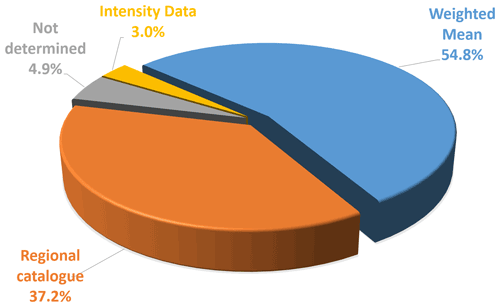
Figure 6Percentages of the different types of magnitudes in EPICA, i.e. reassessed from intensity data, reassessed from a regional parametric catalogue, or the weighted mean of the two reassessments; “Not determined” means that the available data do not allow a robust estimate.
All the Mw estimates in EPICA are accompanied by their uncertainties, determined as follows.
-
For Mw determined from MDPs, the uncertainty provided by the selected method is adopted if larger than 0.3, otherwise it has been fixed at 0.3; BW assesses magnitude uncertainty as a function of the number of MDPs used, MEEP uses a bootstrap resampling technique, and Boxer computes both formal and bootstrap uncertainties.
-
For Mw obtained from regional catalogues the adopted uncertainty is either (i) the uncertainty provided by the catalogue when available; (ii) a default value of 0.3 when Mw is obtained from the conversion of I0 or another type of magnitude or is not available in the source catalogue; or (iii) a default value of 0.5 when the type of the original magnitude is not expressed.
-
For Mw obtained as the weighted mean of the values from MDPs and from regional catalogues, uncertainty is calculated as the square root of the sum of the squares of the uncertainties, each multiplied by its own assigned weight.
Figure 7 shows the geographical distribution of the earthquakes according to the way Mw is determined, and Fig. 8 shows magnitudes in EPICA in different classes and according to their type.
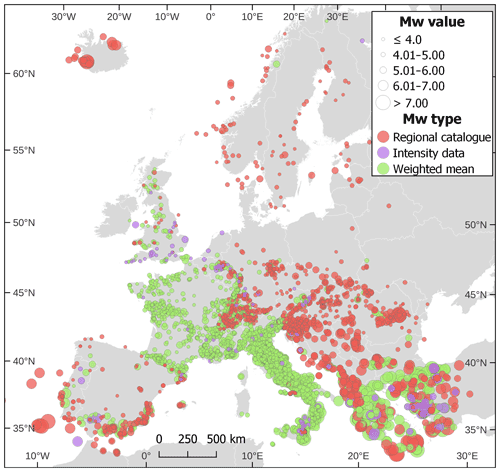
Figure 7Geographical distribution of earthquakes in EPICA according to the value (size of the symbols) and type (colour) of the magnitude: reassessed from intensity data, reassessed from a regional parametric catalogue, or the weighted mean of the two reassessments.
The updates and variations in the input datasets described in the previous sections reflect in several differences between EPICA and SHEEC 1000–1899.
Earthquakes in EPICA are 5703 instead of the 4722 in SHEEC 1000–1899. The reasons for such an increase are the introduction of 46 studies providing MDPs and four catalogues that are not among those used for compiling SHEEC 1000–1899, mostly because they are more recent or, to a lesser extent, they were already published but not considered. The latter are mostly studies on Italian earthquakes, because ASMI did not yet exist and the Italian portion of AHEAD was less updated than the rest of Europe.
In EPICA there are 4668 earthquakes in common with SHEEC 1000–1899, and the records related to half (2332) of them are the same as in SHEEC 1000–1899 (Table 5), i.e. they derive from the same sources of data, either MDP sets (63) or catalogues (1559) or both (710), and thus present the same parameters.
On the other hand, EPICA includes 1035 earthquakes that were not in SHEEC 1000–1899 (Table 5). The majority (696) of these earthquakes derive from 23 descriptive studies and three parametric catalogues published after the compilation of SHEEC 1000–1899, which provide parameters from MDPs to 73 earthquakes, from catalogues to 133 earthquakes and from both to 490 earthquakes. The remaining 339 earthquakes added to EPICA (Table 5) are included from studies or catalogues already considered in SHEEC 1000–1899 because of the intensity/magnitude threshold (319) lowered to intensity 5 or because of the revision of the dataset selection (20 cases). In addition, 2336 earthquakes already listed in SHEEC 1000–1899 are included in EPICA with a different set of data, in most of the cases (1963) because such datasets are new, otherwise the reference dataset has been changed to be consistent with other similar choices (Table 5).
Figure 9 shows the locations of the earthquakes in EPICA and the comparison of their input datasets with respect to SHEEC 1000–1899; fakes in SHEEC 1000–1899 are also mapped.
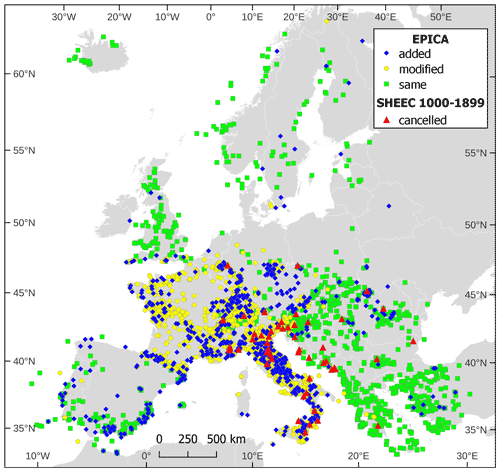
Figure 9Locations of the earthquakes in EPICA, in comparison with SHEEC 1000–1899. Blue diamonds: earthquakes in EPICA that were not in SHEEC 1000–1899; yellow dots: earthquakes in both SHEEC 1000–1899 and EPICA, but with a different dataset; green squares: earthquakes in both SHEEC 1000–1899 and EPICA with the same dataset; red triangles: earthquakes in SHEEC 1000–1899 that were cancelled.
With respect to SHEEC 1000–1899, 49 earthquakes (Appendix A; Fig. 9) are not included in EPICA for the following reasons:
-
Forty-two of them have been assessed as fakes in a new study.
-
Four of them were duplications of other earthquakes.
-
Three of them were in the Swiss catalogue ECOS-02 (Swiss Seismological Service, 2002) but are not included in the updated version ECOS-09 (Fäh et al., 2011) without any motivation.
Besides these newly introduced earthquakes, new sources of data and the revision of the selection of the input datasets also impact on the parameters of 2336 earthquakes (see Table 5). In particular, the parameters of 501 earthquakes rely on new or different sets of MDPs, those of 523 on a new or different regional catalogue, and those of 1312 on both different MDP sets and catalogues. As a whole, the earthquakes with parameters based on the homogeneous and reproducible processing of MDPs increased from 2447 to 3622 in EPICA, with a total of 49 852 considered MDPs instead of 42 581.

Figure 10Comparison between magnitude values in SHEEC 1000–1899 and EPICA for all the earthquakes (a, b) and in each calibration region: (c) Apennines, north-eastern Alps and Dinarides (APD); (d) broad Aegean, shallow (BAS); (e) Betics (BET), broad Aegean, intermediate (BAI), and other areas; (f) Italian volcanic areas (IVA); (g) stable continental region (SCR); (h) Western Alps and Pyrenees (WAP). See also Fig. 4 for the location of the areas.
Figure 10 shows a comparison of the magnitudes of the 4668 earthquakes in both EPICA and SHEEC 1000–1899. In general, variations are mostly (93 %) within ±0.5Mw units, i.e. within the mean associated uncertainty which is 0.47 in EPICA. An overall decrease in the magnitude values, up to 2.0 Mw units, is observed in EPICA (Fig. 10a and b) and mostly affects the lowest magnitudes. The reason for such a decrease is the introduction of the new calibration of the Italian volcanic areas (IVA region; Fig. 10f) and, to a lesser extent, the new calibration in the Apennine–Dinarides region (APD; Fig. 10c). However, for earthquakes in Italy, the magnitude decrease is mostly due to the consistent amount of new macroseismic data available today for earthquakes previously supported only by old catalogues with overestimated epicentral intensity assessments, as discussed in Rovida et al. (2020b; see also Fig. 9). In addition, the new F-CAT17 catalogue for France accounts for the variations in the SCR (stable continental region; Fig. 10g) and WAP (Western Alps–Pyrenees; Fig. 10h) regions. Some of the changes in the WAP and SCR regions are also the effect of the parameterisation of MDPs from ECOS-09 that, for time constraints, were not fully done in SHEEC 1000–1899, and Mw from ECOS-09 catalogue were adopted. The few variations in the Aegean area (BAS; Fig. 10d) are mainly due to the correction of a few entries from the Turkish catalogue (Soysal et al., 1981). No variations are introduced in the BET and BAI regions and, aside from very few revisions, to other areas (Fig. 10e).
Some variations in the earthquake locations were also introduced. Excluding differences due to coordinate rounding, they relate to 1628 earthquakes, with an average distance of 16 km and a maximum of 678 km. The latter very high difference refers to the 28 May 1897 earthquake, for which newly assessed MDPs on the coasts of Southern Italy (Molin et al., 2008) complemented those in Greece and resulted in a more robust location at sea. However, only for 334 earthquakes is the distance from the previous location significant, i.e. ≥20 km. The latter differences are the consequence of the adoption of a new input dataset for 292 earthquakes but also 42 corrections of compilation errors of SHEEC 1000–1899 that affected entries from the Slovenian (Živcic, 2009) and Turkish (Soysal et al., 1981) catalogues. In particular, the variations in the epicentres of earthquakes in Switzerland derive from the already-mentioned parameterisation of MDPs from ECOS-09. Similarly, for French earthquakes the epicentres are calculated from MDPs, while in SHEEC 1000–1899 they were adopted from SisFrance 2010.
EPICA version 1.1 (Rovida and Antonucci, 2021) is available at https://doi.org/10.13127/epica.1.1 and is released under a Creative Commons Attribution 4.0 International (CC BY 4.0) license. The catalogue file is downloadable in both OpenDocument Spreadsheet Document (.ods) and MS Excel (.xlsx) formats. The downloadable spreadsheets contain all catalogue parameters, as described in the previous sections. The description of the file is shown in a dedicated webpage (https://emidius.eu/epica/description_table_fields.htm, last access: 22 March 2022) and contained in a separate sheet of the downloadable files. EPICA version 1.1 is also available through AHEAD's web services according to the standards of the International Federation of Digital Seismograph Networks (fdsnws-event) and the Open Geospatial Consortium, in particular the Web Feature Service (OGC WFS) and the Web Map Service (OGC WMS). As shown in Table 6, the three standards may provide the catalogue encoded in different output formats to meet users' needs. The documentation for these web services is available at https://www.emidius.eu/AHEAD/services/ (last access: 22 March 2022).
The OGC WFS standard returns the complete set of EPICA parameters, whereas the fdsnws-event standard cannot include any macroseismic information (in the case of EPICA, the origin and number of intensity data, the maximum reported intensity, and so on). On the other hand, the fdsnws-event standard allows the user to obtain the earthquake origins and magnitudes from all the alternative catalogues archived in AHEAD, together with the (preferred) solution of EPICA.
EPICA data can be downloaded and displayed in the widely used open source GIS software QGIS, using the QQuake plugin (Locati et al., 2021) that gives access to various types of seismological data – such as parameters, macroseismic intensity data, seismic stations or seismogenic faults – via a set of pre-configured web services. QQuake also allows the users to download the input macroseismic data, obtained from the AHEAD macroseismic web services that works similarly to fdsnws-event but instead of providing QuakeML 1.2, implements the macroseismic package of QuakeML 2.0 (Euchner and Kästli, 2014; Locati, 2014; Euchner et al., 2016; Kästli and Euchner 2018).
Finally, EPICA is also included in AHEAD as the main catalogue and is the reference earthquake catalogue for the period 1000–1899 in the EPOS Integrated Core Service portal (https://www.ics-c.epos-eu.org/; last access: 22 March 2022).
EPICA makes the best possible use of the available knowledge of European historical seismicity, as represented in the European Archive of Historical Earthquake Data (AHEAD), to maximise the harmonisation of earthquake data and parameters across country borders.
Although the procedures for deriving earthquake parameters are the same as in SHEEC 1000–1899, the wealth of new input data causes significant variations with respect to it, emphasising the influence of quality macroseismic data derived from thorough historical investigations on earthquake location and magnitude. The increase in the number of earthquakes with MDPs indicates an overall improvement of the knowledge of the earthquakes, the MDP distributions being the results of modern, thorough historical investigation of primary sources of information. Such an improvement in turn reflects on the reliability of earthquake parameters that can be assessed with objective, homogeneous and repeatable procedures (see Rovida et al., 2020a). Recent guidelines for implementing European data infrastructures, supported by several recent international initiatives such as the European Plate Observing System (EPOS) (Haslinger et al., 2022), greatly contributed to improving the findability and accessibility of input data for compiling EPICA, achieving what was initially envisioned in Van Gils (1988) and Stucchi (1994).
However, the availability and reliability of studies and data across Europe are incomplete and inconsistent, with large differences from one area to the other. In particular, the location of earthquakes with MDPs is not homogeneously distributed, with a substantial lack of them in Northern and central Eastern Europe; and the level of update of the input datasets, both macroseismic studies and parametric catalogues, differs considerably.
In addition, the methods for the definition of macroseismic parameters and their associated uncertainties are unchanged in the last decade and need to be improved.
Such a heterogeneity reflects on the uniformity of any Europe-wide catalogue, and the room for improving the knowledge of the European seismic history is still very large. Unfortunately, despite the widespread perception of the utmost importance of historical macroseismic investigations and data for the knowledge of long-term seismicity, the dedicated resources and work force have been steadily decreasing in recent years in all countries and institutions. In spite of this, AHEAD will continue to collect newly produced data independently of their amount, and EPICA will hopefully be updated on a regular basis, regardless of the requests of specific seismic hazard assessment projects, to incorporate any innovation in terms of both input data and parameterisation procedures and will possibly be expanded to neighbouring areas and to recent times.
AR and AA curated the dataset. ML developed the web services for accessing the dataset. The three authors contributed to the manuscript and approved the final version.
The contact author has declared that none of the authors has any competing interests.
Publisher’s note: Copernicus Publications remains neutral with regard to jurisdictional claims in published maps and institutional affiliations.
We are indebted to the authors of SHEEC 1000–1899, in particular Massimiliano Stucchi, for their major and ground-breaking effort in harmonising earthquake data across Europe and to the countless researchers who contributed through time to the writing of the seismic history of Europe. We are grateful to our colleague Paola Albini for her precious contributions and constant support. We also thank the numerous colleagues, contributors and regional experts who provided us with their expertise, valuable feedback and suggestions. We wish to thank the ESHM2020 Core Group, in particular Laurentiu Danciu, and the coordinators of the SERA WP 25, Fabrice Cotton and Stefan Weimer, and of the SERA Project, Domenico Giardini, for encouraging this effort and having made it possible.
We are grateful to ESSD topical editor Kirsten Elger for handling the review process and to Mathilde Sørensen, Jana Pazdírková and Alessandro Rebez for their reviews.
This research has been supported by the European Union's Horizon 2020 Research and Innovation Programme under grant agreement no. 730900.
This paper was edited by Kirsten Elger and reviewed by Alessandro Rebez, Mathilde Sørensen and Jana Pazdírková.
Albini, P. and Rovida, A.: Earthquakes in southern Dalmatia and coastal Montenegro before the large 6 April 1667 event, J. Seismol., 22, 3, 721–754, https://doi.org/10.1007/s10950-018-9730-4, 2018.
Albini, P., Locati, M., Rovida, A. and Stucchi, M.: European Archive of Historical EArthquake Data (AHEAD), INGV [data set], https://doi.org/10.6092/ingv.it-ahead, 2013.
Alexandre, P. and Alexandre, D.: Les séismes en Europe orientale au Moyen Âge, Ciel et Terre, 128, 162–175, 2012.
Ambraseys, N. N. and Sigbjörnsson, R.: Re-appraisal of the seismicity of Iceland, Earthquake Engineering Research Centre, Selfoss, 196, 2000.
Azzaro, R., D'Amico, S., and Tuvè, T.: Estimating the magnitude of historical earthquakes from macroseismic intensity data: new relationships for the volcanic region of Mount Etna (Italy), Seismol. Res. Lett., 82, 533–544, https://doi.org/10.1785/gssrl.82.4.533, 2011.
Bakun, W. H. and Wentworth, C. M.: Estimating earthquake location and magnitude from seismic intensity data, B. Seismol. Soc. Am., 87, 1502–1521, 1997.
Bakun, W. H., Gomez Capera, A., and Stucchi, M.: Epistemic uncertainty in the location and magnitude of earthquakes in Italy from macroseismic data, B. Seismol. Soc. Am., 101, 2712–2725, https://doi.org/10.1785/0120110118, 2011.
Basili, R., Carafa, M. M. C., Kastelic, V., Maesano, F. E., Tiberti, M. M., Rovida, A., Antonucci, A., Weatherill, G., Lammers, S., and Danciu, L.: D25.2 – Updated databases of seismicity, faults, and strain rates for ESHM20, Deliverable 25.2, WP25 of the SERA (Seismology and Earthquake Engineering Research Infrastructure Alliance for Europe), Project, Horizon 2020 Research and Innovation programme, grant agreement No 730900, 70, 2018.
Beauval, C., Bard, P. Y., and Danciu, L.: The influence of source- and ground-motion model choices on probabilistic seismic hazard levels at 6 sites in France, B. Earthq. Eng., 18, 4551–4580, https://doi.org/10.1007/s10518-020-00879-z, 2020.
Boborikin, A. M., Gareckij, R. G., Emeljanow, A. P., Cildvee, C. C., and Cuvejedis, P. I.: Sowremennoye sostoyaniye seismitsheskich nablyudenhiy i ich obobshtsheniy, Semletryasseniya Belarussi i Pribaltiki, Minsk, Belorussia, 29–40, 1993.
BRGM-EDF-IRSN/SisFrance: Histoire et caractéristiques des séismes ressentis en France, BRGM [data set], http://www.sisfrance.net/ (last access: 22 March 2022), 2016.
Bungum, H., Lindholm, C. D., and Dahle, A.: Long-period ground-motions for large European earthquakes, 1905–1992, and comparisons with stochastic predictions, J. Seismol., 7, 377–396, https://doi.org/10.1023/A:1024505229355, 2003.
Camassi, R. and Castelli, V.: The curious case of the 1346 earthquake recorded only by very young chroniclers, Seismol. Res. Lett., 84, 1089–1097, https://doi.org/10.1785/0220130063, 2013.
Camassi, R., Bernardini, F., Castelli, V., and Meletti, C.: A 17th Century Destructive Seismic Crisis in the Gargano Area: Its Implications on the Understanding of Local Seismicity, J. Earthq. Eng., 12, 1223–1245, https://doi.org/10.1080/13632460802212774, 2008.
Camassi, R., Castelli, V., Molin, D., Bernardini, F., Caracciolo, C.H., Ercolani, E., and Postpischl, L.: Materiali per un catalogo dei terremoti italiani: eventi sconosciuti, rivalutati o riscoperti. Quaderni di Geofisica, 96, Istituto Nazionale di Geofisica e Vulcanologia (INGV), Roma, 53 pp., 2011.
Camassi, R., Caracciolo, C.H., Castelli, V., Ercolani, E., Bernardini, F., Albini, P., and Rovida, A.: Contributo INGV al WP2 del progetto HAREIA – Historical and Recent Earthquakes in Italy and Austria: Studio della sismicità storica del Friuli Venezia-Giulia, Veneto e Alto Adige. Rapporto finale, Istituto Nazionale di Geofisica e Vulcanologia (INGV), Bologna, 23 pp., 2012.
Camassi, R., Castelli, V., Caracciolo, C. H., Ercolani, E., and Bernardini, F.: Revisione speditiva di alcuni terremoti di area nord occidentale. Rapporto interno, Istituto Nazionale di Geofisica e Vulcanologia (INGV), Bologna, 52 pp., 2015.
Castelli, V., Monachesi, G., Moroni, A., and Stucchi, M. (Eds.): I terremoti toscani dall'anno 1000 al 1880: schede sintetiche. GNDT, Rapporto interno, Macerata-Milano, 314 pp., 1996.
Cecić, I., Musson, R. M. W., and Stucchi, M.: Do seismologists agree upon epicentre determination from macroseismic data? A survey of ESC Working Group “Macroseismology”, Ann. Geophys.-Italy, 39, 1013–1027, https://doi.org/10.4401/ag-4031, 1996.
CPTI Working Group: Catalogo Parametrico dei Terremoti Italiani, versione 2004 (CPTI04), INGV [data set], Bologna, https://doi.org/10.6092/INGV.IT-CPTI04, 2004.
Danciu, L., Nandan, S., Reyes, C., Basili, R., Weatherill, G., Beauval, C., Rovida, A., Vilanova, S., Sesetyan, K., Bard, P. Y., Cotton, F., Wiemer, S., and Giardini, D.: The 2020 update of the European Seismic Hazard Model: Model Overview, EFEHR Technical Rep. 001, https://doi.org/10.12686/a15, 2021.
Euchner, F. and Kästli, P.: Towards quakeml 2.0: new packages, techniques, tools, 2nd European conference on earthquake engineering and seismology, online, 25–29 August 2014, 2ECCES, http://www.eaee.org/Media/Default/2ECCES/2ecces_esc/2824.pdf (last access: 22 March 2022), 2014.
Euchner, F., Kästli, P., Heiniger, L., Saul, J., Schorlemmer, D., and Clinton, J.: QuakeML 2.0: recent developments, EGU General Assembly 2016, 17–22 April 2016, online, EGU2016–13830, https://meetingorganizer.copernicus.org/EGU2016/EGU2016-13830-1.pdf (last access: 22 March 2022), 2016.
Fäh, D., Giardini, D., Kästli, P., Deichmann, N., Gisler, M., Schwarz-Zanetti, G., Alvarez-Rubio, S., Sellami, S., Edwards, B., Allmann, B., Bethmann, F., Wössner, J., Gassner-Stamm, G., Fritsche, S., and Eberhard, D.: ECOS-09 Earthquake Catalogue of Switzerland Release 2011 report and database, Swiss Seismological Service ETH Zurich, Rep. SED/RISK/R/001/20110417, 2011.
Gasperini, P, Bernardini, F, Valensise, G., and Boschi, E.: Defining seismogenic sources from historical earthquake felt reports, B. Seismol. Soc. Am., 89, 94–110, 1999.
Gasperini, P., Vannucci, G., Tripone, D., and Boschi, E.: The Location and Sizing of Historical Earthquakes Using the Attenuation of Macroseismic Intensity with Distance, B. Seismol. Soc. Am., 100, 2035–2066, https://doi.org/10.1785/0120090330, 2010.
Gomez Capera, A. A., Rovida, A., Gasperini, P., Stucchi, M., and Viganò D.: The determination of earthquake location and magnitude from macroseismic data in Europe, B. Earthq. Eng., 13, 1249–1280, https://doi.org/10.1007/s10518-014-9672-3, 2015.
Grigorova, E., Christoskov, L., Sokerova, D., Rizhikova, S., and Roglinov A.: Catalogue of earthquakes in Bulgaria and the nearby territories during the period 1st cent. BC – 1977, Archives Geophys. Inst., Bulg. Acad. Sci., Sofia, 1978.
Grünthal, G.: Erdbebenkatalog der Territoriums der Deutschen Demokratischen Republik und angrenzender Gebiete von 823 bis 1984, Veröff. Zentralinst. Physik der Erde, Potsdam, 139, 1988.
Grünthal, G. and Wahlström, R.: The European-Mediterranean Earthquake Catalogue (EMEC) for the last millennium, J. Seismol., 16, 535–570, https://doi.org/10.1007/s10950-012-9302-y, 2012.
Grünthal, G., Wahlström, R., and Stromeyer, D.: The unified catalogue of earthquakes in central, northern and northwestern Europe (CENEC) – updated and expanded to the last millennium, J. Seismol., 13, 514–541, https://doi.org/10.1007/s10950-008-9144-9, 2009.
Grünthal, G., Wahlström, R., and Stromeyer, D.: The SHARE European Earthquake Catalogue (SHEEC) for the time period 1900–2006 and its comparison to the European-Mediterranean Earthquake Catalogue (EMEC), J. Seismol. 17, 1339–1344, https://doi.org/10.1007/s10950-013-9379-y, 2013.
Guidoboni, E., Ferrari, G., Mariotti, D., Comastri, A., Tarabusi, G., Sgattoni, G., and Valensise, G.: CFTI5Med, Catalogo dei Forti Terremoti in Italia (461 a.C.–1997) e nell'area Mediterranea (760 a.C.–1500), INGV [data set], https://doi.org/10.6092/ingv.it-cfti5, 2018.
Hammerl, C.: The four strongest earthquakes in Tyrol/ Austria during XVIth and XVIIth centuries: from archival sources to macroseismic intensities, Acta Geod. Geophys., 50, 39–62, https://doi.org/10.1007/s40328-014-0083-3, 2015.
Hammerl, C. and Lenhardt, W. A.: Erdbeben in Niederösterreich von 1000 bis 2009 n. Chr., Abhandlungen Der Geologischen Bundesanstalt, Band, Wien, 297, 2013.
Haslinger, F., Basili, R., Bossu, R., Cauzzi, C., Cotton, F., Crowley, H., Custodio, S., Danciu, L., Locati, M., Michelini, A., Molinari, I., Ottemöller, L., and Parolai, S.: Coordinated and Interoperable Seismological Data and Product Services in Europe: the EPOS Thematic Core Service for Seismology, Ann. Geophys. 65, DM213, https://doi.org/10.4401/ag-8767, 2022.
Herak, M.: Earthquake Catalog of Croatia and adjacent Regions, Archives of the Andrija Mohorovicic Geophysical Institute, Zagreb, 1995.
Icelandic Meteorological Office: Earthquakes in Iceland larger than magnitude 4 in the years 1706–1990, http://hraun.vedur.is/ja/ymislegt/storskjalf.html (last access: 22 March 2022), 2007.
Instituto Geografíco Nacional: Bases de datos macrosísmica, http://www.ign.es/ign/layoutIn/bdmacrosismica.do (last access: 22 March 2022), 2010.
Kárník, V.: Seismicity of the European area, Part 1, Reidel Publishing Company, Dordrecht, Holland, 361, 1969.
Kárník, V.: Seismicity of the European area, Part 2, Reidel Publishing Company, Dordrecht, Holland, 218, 1971.
Kästli, P. and Euchner, F.: QuakeML 2.0: data model on site characterization, presentation at the COSMOS Guidelines, European Seismological Commission (36th ESC-GA), 6 September 2018.
Kondorskaya, N. V. and Shebalin, N. V. (Eds.): New Catalogue of strong earthquakes in the USSR from ancient times through 1975, World Data Center A for Solid Earth Geophysics, Rep. SE-31, Boulder, Colorado, 608, 1982.
Kondorskaya, N. V. and Ulomov, V. I.: Special earthquake catalogue of Northern Eurasia from ancient times through 1995 (SECNE), Joint Institute of Physics of the Earth (JIPE), Russian Academy of Sciences, Moscow, Russia, 1999.
Kouskouna, V. and Sakkas, G.: The University of Athens Hellenic Macroseismic Database (HMDB.UoA): historical earthquakes, J. Seismol., 17, 1253–1280, https://doi.org/10.1007/s10950-013-9390-3, 2013.
Labak, P. and Broucek, I.: Catalogue of macroseismically observed earthquakes on the territory of Slovakia starting from the year 1034, Geophysical Institute of the Slovak Academy of Sciences, Bratislava, 1995.
Lehmann, K. and Leydecker, G.: Das angebliche Schadenbeben von Köln am 24. Oktober 1841 – Geschichte einer Verwechslung. 74 Jahrestagung der Deutschen Geophysikalischen Gesellschaft Karlsruhe, 10–13 März 2014, p. 232, 2014.
Leydecker, G.: Earthquake Catalogue for Germany and Adjacent Areas for the Years 800–2008, Federal Institute for Geosciences and Natural Resources, Hannover, 2011.
LNEC: A Sismicidade Histórica e a Revisão do Catálogo Sísmico, Laboratorio Nacional de Engenharia Civil, Lisboa, 189, 1986.
Locati, M.: Describing non-instrumental seismological data in QuakeML: the need for a macroseismic extension, 2nd European conference on earthquake engineering and seismology, online, 25–29 August 2014, 2ECCES, http://hdl.handle.net/2122/11271, 2014.
Locati, M., Rovida, A., Albini, P., and Stucchi, M.: The AHEAD portal: a gateway to European historical earthquake data, Seismol. Res. Lett., 85, 727–734, https://doi.org/10.1785/0220130113, 2014.
Locati, M., Vallone, R., Ghetta, M., and Dawson, N.: QQuake, a QGIS plugin for loading seismological data from web services, Front. Earth. Sci., 9, 2296–6463, https://doi.org/10.3389/feart.2021.614663, 2021.
Manchuel, K., Traversa, P., Baumont, D., Cara, M., Nayman, E., and Durouchoux, C.: The French seismic CATalogue (FCAT-17), B. Earthq. Eng., 16, 2227–2251, https://doi.org/10.1007/s10518-017-0236-1, 2018.
Martinez Solares, J. and Lopez Arroyo, A.: The great historical 1755 earthquake, effects and damage in Spain, J. Seismol. 8, 275–294, https://doi.org/10.1023/B:JOSE.0000021365.94606.03, 2004.
Martinez Solares, J. M. and Mezcua Rodriguez, J. (Eds.): Catalogo sismico de la Peninsula Iberica (880 a.C.–1990), IGN, Madrid, Monografía Núm, 18, 254 pp., 2002.
Martins, I. and Mendes Victor, L. A.: Contribuiçao para o estudo da sismicidade da regiao oeste da peninsula iberica, Universidade de Lisboa, Instituto Geofisico do Infante D. Luis, Publ. N. 25, 67, 2001.
Meidow, H.: Rekonstruktion und Reinterpretation von historischen Erdbeben in den nördlichen Rheinlanden unter Berücksichtigung der Erfahrungen bei dem Erdbeben von Roermond am 13. April 1992, PhD Thesis, University of Köln, 305 pp., 1995.
Molin, D., Bernardini, F., Camassi, R., Caracciolo, C. H., Castelli, V., Ercolani, E., and Postpischl, L.: Materiali per un catalogo dei terremoti italiani: revisione della sismicità minore del territorio nazionale, Quaderni di Geofisica, 57, 75 pp., 2008.
Musson, R. M. W.: Earthquake Catalogue of Great Britain and surroundings, British Geological Survey, Technical Rep. WL/94/04, Edinburgh, 99, 1994.
Musson, R. M. W. and Jimenéz, M. J.: Macroseismic estimation of earthquake parameters, NA4 deliverable D3, NERIES Project, 2008.
Musson, R. M. W. and Sargeant, S. L.: BGS UK Earthquake Database, Eurocode 8 seismic hazard zoning maps for the UK, British Geological Survey, Technical Rep. CR/07/125, 2007.
Nikonov, A. A.: Distribution of maximum observed tremors and zones of possible occurrence of earthquakes in Estonia, Izvestiya, Earth Physics, 28, 430–434, 1992.
Observatoire Royal de Belgique: Data files of the Observatoire Royal de Belgique [data set], Brussels, Belgium, 2010.
Olivera, C., Redondo, E., Lambert, J., Riera Melis, A., and Roca, A.: Els terratrèmols dels segles XIV I XV a Catalunya, Barcelona, Institut Cartogràfic de Catalunya, 407, 2006.
Oncescu, M. C., Marza, V. I., Rizescu, M., and Popa, M.: The Romanian earthquake catalogue between 984–1997, in: contributions from the First International Workshop on Vrancea Earthquakes, edited by: Wenzel, F. and Lungu, D., Bucharest, Romania, Kluwer Academic Publishers, 43–48, https://doi.org/10.1007/978-94-011-4748-4_4, 1999.
Pagaczewski, J.: Catalogue of earthquakes in Poland 1000–1970 Years, Publications of the Institute of Geophysics, Polish Academy of Sciences, 51, 61 pp., 1972.
Papazachos, B. C. and Papazachou, C.: The earthquakes of Greece, Ziti publications, Thessaloniki, Greece, 286 pp., 2003.
Peláez, J. A., Chourak, M., Tadili, B. A., Aït Brahim, L., Hamdache, M., López Casado, C., and Martínez Solares, J. M.: A Catalog of Main Moroccan Earthquakes from 1045 to 2005, Seismol. Res. Lett., 78, 614–621, https://doi.org/10.1785/gssrl.78.6.614, 2007.
Petrosino, S., De Siena, L., and Del Pezzo, E.: Recalibration of the magnitude scales at Campi Flegrei, Italy, on the basis of measured path and site and transfer functions, B. Seismol. Soc. Am., 98, 1964–1974, https://doi.org/10.1785/0120070131, 2008.
Provost, L., Antonucci, A., Rovida, A., and Scotti, O.: Comparison between two methodologies for assessing historical earthquake parameters and their impact on seismicity rates in the western Alps, Pure Appl. Geophys., 179, 569–586, https://doi.org/10.1007/s00024-021-02943-4, 2022.
Rong, Y., Mahdyiar, M., Shen-Tu, B., and Shabestari, K.: Magnitude problems in historical earthquake catalogues and their impact on seismic hazard assessment, Geophys. J. Int., 187, 1687–1698, https://doi.org/10.1111/j.1365-246X.2011.05226.x, 2011.
Rovida, A. and Antonucci, A.: EPICA – European PreInstrumental Earthquake CAtalogue, version 1.1, INGV [data set], https://doi.org/10.13127/epica.1.1, 2021.
Rovida, A. and Locati, M.: Archive of Historical Earthquake Data for the European-Mediterranean Area, in: Perspectives on European Earthquake Engineering and Seismology, edited by: Ansal, A., Geot. Geol. Earthquake, 359–369, https://doi.org/10.1007/978-3-319-16964-4_14, 2015.
Rovida, A., Locati, M., Camassi, R., Lolli, B., and Gasperini, P.: CPTI15, the 2015 version of the Parametric Catalogue of Italian Earthquakes, INGV [data set], https://doi.org/10.6092/INGV.IT-CPTI15, 2016.
Rovida, A., Locati, M., Antonucci, A., and Camassi, R.: Italian Archive of Historical Earthquake Data (ASMI), INGV [data set], https://doi.org/10.13127/asmi, 2017.
Rovida, A., Albini, P., Locati, M., and Antonucci, A.: Insights into Preinstrumental Earthquake Data and Catalogs in Europe, Seismol. Res. Lett., 91, 2546–2553, https://doi.org/10.1785/0220200058, 2020a.
Rovida, A., Locati, M., Camassi, R., Lolli, B., and Gasperini, P.: The Italian earthquake catalogue CPTI15, B. Earthq. Eng., 18, 2953–2984, https://doi.org/10.1007/s10518-020-00818-y, 2020b.
Rovida, A., Locati, M., Antonucci, A., and Albini, P.: Ten years of the European Archive of Historical Earthquake Data AHEAD, European Seismological Commission (37th ESC), 19–24 September 2021, online, ESC2021-S37-247, 2021.
Rovida, A., Locati, M., Camassi, R., Lolli, B., Gasperini, P., and Antonucci, A.: Catalogo Parametrico dei Terremoti Italiani (CPTI15), versione 4.0, INGV [data set], https://doi.org/10.13127/CPTI/CPTI15.4, 2022.
Shebalin, N. V. and Leydecker, G.: Earthquake Catalogue for Central and Southeastern Europe 342 BC-1990 AD, Final Rep. to Contract ETNU, CT 93 – 0087, 1998.
Shebalin, N. V., Karnik, V., and Hadzievski, D. (Eds.): Catalogue of earthquakes of the Balkan region. I, UNDP-UNESCO Survey of the seismicity of the Balkan region, Skopje, 600, 1974.
Soysal, H., Sipahioglu, S., Kolcak, D., and Altinok, Y.: Turkye ve Cevresinin Tarihsel deprem Katalogu, TUBITAK, Proje no. TBAG 341, Istanbul, 86, 1981.
Stucchi, M.: Recommendations for the compilation of a European parametric earthquake catalogue, with special reference to historical records, in: Materials of CEC Project Review of Historical Seismicity in Europe, edited by: Albini, P. and Moroni, A., CNR, Milano, 1994.
Stucchi, M., Rovida, A., Gomez Capera, A. A., Alexandre, P., Camelbeeck, T., Demircioglu, M. B., Gasperini, P., Kouskouna, V., Musson, R. M. W., Radulian, M., Sesetyan, K., Vilanova, S., Baumont, D., Bungum, H., Fäh, D., Lenhardt, W., Makropoulos, K., Martinez Solares, J. M., Scotti, O., Živcic, M., Albini, P., Batllo, J., Papaioannou, C., Tatevossian, R., Locati, M., Meletti, C., Viganò D., and Giardini, D.: The SHARE European Earthquake Catalogue (SHEEC) 1000–1899, J. Seismol., 17, 523–544, https://doi.org/10.1007/s10950-012-9335-2, 2013.
Sulstarova, E. and Kociu, S.: The catalogue of Albanian earthquakes, Botim i Qendres Sizmologjike, Tirane, 223, 1975.
Swiss Seismological Service: ECOS – Earthquake Catalog of Switzerland ECOS report to PEGASOS, version 31.03.2002 SED, Zürich, 2002.
Taxeidis, K.: Study of historical seismicity of the eastern Aegean islands, Ph.D. Thesis, N&K University of Athens, Greece, 301 pp., 2003.
Tuvè, T., D'Amico, S., and Giampiccolo, E.: A new MD-ML relationship for Mt. Etna earthquakes (Italy). Ann. Geophys.-Italy, 58, S0657, https://doi.org/10.4401/ag-6830, 2015.
University of Helsinki: Catalog of earthquakes in Northern Europe (FENCAT), 1375, https://www.seismo.helsinki.fi/bulletin/list/catalog/Scandia_updated.html (last access: 22 March 2022), 2007.
University of Thessaloniki: Macroseismic Data used for the compilation of Papazachos and Papazachou (2003) catalogue, [data set], http://www.itsak.gr/en/db/data/macroseismic_data/ (last access: 22 March 2022), 2003.
Van Gils, J. M.: Catalogue of European earthquakes and an atlas of European seismic maps, CEC, Nuclear Science and Technology, Rep. EUR 11344 EN, 168, 1988.
Van Gils, J. M. and Leydecker, G.: Catalogue of European Earthquakes with intensities higher than 4, CEC, Nuclear Science and Technology, Rep. EUR 13406 EN, 353, 1991.
Vilanova, S. P. and Fonseca, J. F. B. D.: Probabilistic Seismic-Hazard Assessment for Portugal, B. Seismol. Soc. Am., 97, 1702–1717, https://doi.org/10.1785/0120050198, 2007.
Wössner, J., Danciu, L., Giardini, D., Crowley, H., Cotton, F., Grünthal, G., Valensise, G., Arvidsson, R., Basili, R., Demircioglu, M. B., Hiemer, S., Meletti, C., Musson, R., Rovida, A., Sesetyan, K., and Stucchi, M.: The 2013 European Seismic hazard model: key components and results, B. Earthq. Eng., 13, 3553–3596, https://doi.org/10.1007/s10518-015-9795-1, 2015.
ZAMG: AEC2010. Austrian Earthquake Catalogue – A List of Felt Earthquakes, Computer-file compiled by the Department of Geophysics, Zentralanstalt fuer Meteorologie und Geodynamik, Vienna, Austria, 2010.
Živcic, M.: Earthquake Catalogue of Slovenia, http://gis.arso.gov.si/atlasokolja/profile.aspx?id=Atlas_Okolja_AXL@Arso (last access: 22 March 2022), 2009.
Zsìros, T., Mónus, P., and Tóth, L.: Hungarian Earthquake Catalog (456–1986), Geodetic & Geophysical Research Institute, Budapest, 182, 1988.





